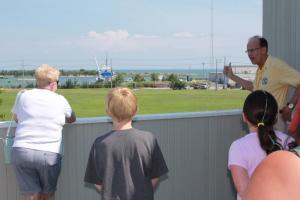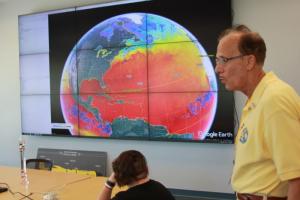Tours of the University of Delaware Lewes campus are back in swing after an absence last summer because of renovations.
“We want to let people know that tours are available again,” said Jerry Klavans, one of several docents who leads tours through the two buildings that make up UD's Lewes campus.
The Hugh R. Sharp campus works in conjunction with the Newark campus to provide courses through The College of Earth, Ocean and Environment. During the school year, two-way interactive televisions allow students to participate in classes from either location.
The Lewes campus is primarily made up of two buildings – the Cannon Laboratory and the Smith Laboratory. The buildings provide classrooms and research facilities to study fisheries, wetlands restoration and marine life.
A research vessel, Hugh R. Sharp, was built with state-of-the-art technology for coastal research and exploration. Also parked in the UD marina is a vessel leased by several oil companies that can use the vessel in cleanup of small oil spills. “Within five minutes that vessel is ready to go,” Klavans said.
Those spills, however, have been rare and easily cleaned up, he said.
UD has also invested in drones to survey the landscape, both quad-helicopter designs and drones that are built like miniature airplanes, said Mark Jolly-Van Bodegraven, director of environmental public education for Delaware Sea Grant College Program.
In the Otis Laboratory, a Global Visualization Lab uses a nine-panel screen that takes up one wall to show weather trends, water temperatures, and other physical and biological observations worldwide.
On July 10, UD graduate students were working on research that involves sturgeon – an endangered fish that swims along the Atlantic seaboard. Students have tagged the fish to study where they swim, and to warn fishermen to avoid them.
“They can be heard by receivers which can pinpoint where the fish are,” said grad student Joe Gradone.
Down the hall from the Global Visualization lab, one researcher is looking into whether sunscreen worn by humans and washed off into the ocean could have an effect on horseshoe crabs.
“This area off the Delaware Bay is a main area for horseshoe crabs,” Klavans said to a group of 10 taking the tour.
A greenhouse provides plenty of phragmites and seashore mallow – a plant that could be used for bedding in chicken houses.
A robotics laboratory has unmanned underwater vehicles that can study the underwater shoreline.
Docent Irv Eberhard said brochures have been placed throughout the community to let people know about the tours. He said special tours can be arranged for groups such as schools and senior centers.
Tours are offered 10 a.m. to noon Monday, Wednesday and Friday through August. The last tour is Friday, Sept. 1. For more information, call 302-645-4234.




























































